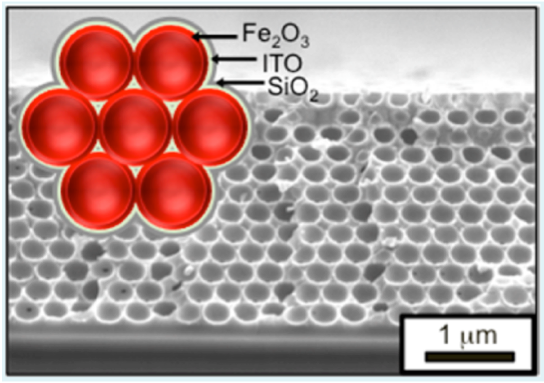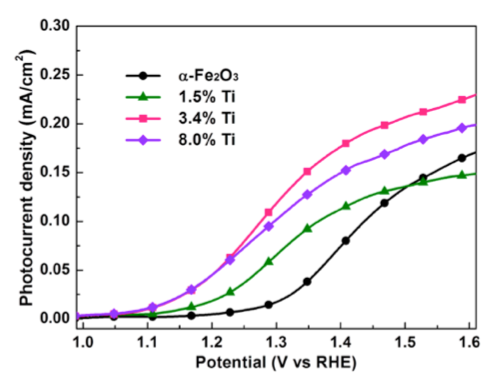水分解
水分解技術は、化学反応を利用して水(H2O)を酸素と水素に分離するプロセスを特徴としています。電気分解、光合成、光電気化学、光触媒作用、放射線分解、光生物学、熱分解など、さまざまなテクニックを用いることで、水分解を効果的に行うことができます。最新の成果はナノ粒子と薄膜触媒を使用してより低い反応温度で水を分解することに焦点を当てており、高度にコンフォーマルな原子層蒸着(ALD)は太陽電池効率の最適化に重要であることが証明されています。経済的で効率的な水分解は、代替のエネルギー源として、水素を生成するための重要な要素になっています。この分野の研究で、水素経済への移行を実現する可能性が調査され、テストされることでしょう。
水の光酸化
原子層蒸着(ALD)技術を使用すると、ウエハ分割用途に適した高表面積構造を作ることができます。高表面積導電・透明フレームワークの製造は、水の光酸化(水分解)に使用するために開発されました。
Savannah®S200を使用する原子層蒸着(ALD)膜は、高表面積ナノ構造を生成するために、ITOおよびFe2O3用のExposure Mode技術を使用して逆オパール構造上に蒸着されました。

水の光酸化向け高表面積導電・透明フレームワーク。原子層蒸着(ALD)により、酸化鉄Fe2O3、ITO、およびSiO2が逆骨格構造上に蒸着されています。参照:Riha, S. C, et al.. Acs Appl Mater Inter 5, 360–367 (2013).
膜
- InCp、TDMASn、およびO3を使用した酸化インジウムスズ(ITO)
- FeCp2とO3を使用したフェロセン(Fe2O3)
結果
- 原子層蒸着(ALD)技術を使用して水を分解するために、透明性が高い大表面積ナノ積層スタックが作成されました。
- 水の酸化の開始は-200mVに変化し、可逆水素電極に対する1.53Vの光電流は3倍になりました(平坦な光陽極と比較)。
Fe2O3のTi置換による緑色光酸化
極薄(厚さ6nm)ヘマタイト変換効率、特に緑色の光子によって生成される正孔収集効率(500~600nm)に改善するためにTi合金が使用されました。この研究では、Savannah®S200を使用してTiO2とFe2O3の両方の膜を蒸着しました。

水の光電気化学的酸化用の触媒利用を促進するためにFe2O3のチタニウム合金を使用します。参照:Kim, D. W. et al. Greenlighting Photoelectrochemical Oxidation of Water by Iron Oxide. ACS Nano 141203161851003 (2014).
結果
- 極薄Fe2O3でTiを代用することにより、表面に局在する穴の寿命が延びます。
- Tiが代用された膜で光電流性能の向上が観察されました。
- 特に500 – 600 nmの範囲で、光子電流吸収効率 (APCE) の向上が見られました。
- 光吸収における変化は見受けられませんでした。
参考資料 – Veeco CNT ALDプラットフォームで行われた最新の刊行物
- Dias, P. et al. Transparent Cuprous Oxide Photocathode Enabling a Stacked Tandem Cell for Unbiased Water Splitting. Adv. Energy Mater. n/a–n/a (2015). doi:10.1002/aenm.201501537
- Luo, J. et al. Targeting Ideal Dual‐Absorber Tandem Water Splitting Using Perovskite Photovoltaics and CuInxGa1‐xSe2 Photocathodes. Adv. Energy Mater. (2015). doi:10.1002/aenm.201501520
- Landsmann, S. et al. Design Guidelines for High-Performance Particle-Based Photoanodes for Water Splitting: Lanthanum Titanium Oxynitride as a Model. ChemSusChem n/a–n/a (2015). doi:10.1002/cssc.201500830
- Barreca, D. et al. Fe2O3–TiO2 Nano‐heterostructure Photoanodes for Highly Efficient Solar Water Oxidation. Advanced Materials Interfaces n/a–n/a (2015). doi:10.1002/admi.201500313
- Michaux, K. E. et al. Visible Photoelectrochemical Water Splitting Based on a Ru(II) Polypyridyl Chromophore and Iridium Oxide Nanoparticle Catalyst. The Journal of … (2015). doi:10.1021/acs.jpcc.5b05711
- Luo, J. et al. Solution Transformation of Cu2O into CuInS2 for Solar Water Splitting. Nano Lett 15, 1395–1402 (2015).
- Schoen, D. T., Atre, A. C., García-Etxarri, A., Dionne, J. A. & Brongersma, M. L. Probing Complex Reflection Coefficients in One-Dimensional Surface Plasmon Polariton Waveguides and Cavities Using STEM EELS. Nano Lett 15, 1–8 (2014).
- Kim, D. W. et al. Greenlighting Photoelectrochemical Oxidation of Water by Iron Oxide. ACS Nano 141203161851003 (2014). doi:10.1021/nn503869n
- Azevedo, J. et al. On the stability enhancement of cuprous oxide water splitting photocathodes by low temperature steam annealing. Energy Environ. Sci. 7, 4044–4052 (2014).
- Yang, X. et al. Improving Hematite-based Photoelectrochemical Water Splitting with Ultrathin TiO 2by Atomic Layer Deposition. Acs Appl Mater Inter 140804065734002 (2014). doi:10.1021/am500948t
- Klahr, B. & Hamann, T. Water Oxidation on Hematite Photoelectrodes: Insight into the Nature of Surface States through In Situ Spectroelectrochemistry. J. Phys. Chem. C 118, 10393–10399 (2014).
- Zandi, O., Beardslee, J. A. & Hamann, T. Substrate Dependent Water Splitting with Ultrathin α-Fe 2O 3Electrodes. J. Phys. Chem. C 140501145249004 (2014). doi:10.1021/jp4116657
- Tilley, D. S. & Grätzel, M. Ruthenium Oxide Hydrogen Evolution Catalysis on Composite Cuprous Oxide Water-Splitting Photocathodes. Advanced Functional … 1–9 (2014). doi:10.1002/adfm201301106
- Yang, X., Du, C., Liu, R., Xie, J. & Wang, D. Balancing photovoltage generation and charge-transfer enhancement for catalyst-decorated photoelectrochemical water splitting: A case study of the hematite/MnOx combination. Journal of Catalysis 304, 86–91 (2013).
- Liu, M., Nam, C.-Y., Black, C. T., Kamcev, J. & Zhang, L. Enhancing Water Splitting Activity and Chemical Stability of Zinc Oxide Nanowire Photoanodes with Ultrathin Titania Shells. J. Phys. Chem. C 130610143036005 (2013). doi:10.1021/jp404032p
- Riha, S. C. et al. Atomic Layer Deposition of a Sub-Monolayer Catalyst for the Enhanced Photoelectrochemical Performance of Water Oxidation with Hematite. ACS Nano 130212010712000 (2013). doi:10.1021/nn305639z
- Riha, S. C., DeVries Vermeer, M. J., Pellin, M. J., Hupp, J. T. & Martinson, A. B. F. Hematite-based Photo-oxidation of Water Using Transparent Distributed Current Collectors. Acs Appl Mater Inter 5, 360–367 (2013).
- Klug, J. A. et al. Low temperature atomic layer deposition of highly photoactive hematite using iron(iii) chloride and water. J. Mater. Chem. A 1, 11607 (2013).
- Maijenburg, A. W. et al. Electrochemical synthesis of coaxial TiO2-Ag nanowires and their application in photocatalytic water splitting. J. Mater. Chem. A (2013). doi:10.1039/c3ta14551d
- Klahr, B., Gimenez, S., Fabregat-Santiago, F., Bisquert, J. & Hamann, T. W. Photoelectrochemical and Impedance Spectroscopic Investigation of Water Oxidation with ‘Co–Pi’-Coated Hematite Electrodes. J Am Chem Soc 134, 16693–16700 (2012).
- Paracchino, A. et al. Ultrathin films on copper(I) oxide water splitting photocathodes: a study on performance and stability. Energy & Environmental Science 5, 8673–8681 (2012).
- Klahr, B., Gimenez, S., Fabregat-Santiago, F., Bisquert, J. & Hamann, T. W. Electrochemical and photoelectrochemical investigation of water oxidation with hematite electrodes. Energy & Environmental Science 5, 7626–7636 (2012).
- Klahr, B. M., Martinson, A. B. F. & Hamann, T. W. Photoelectrochemical Investigation of Ultrathin Film Iron Oxide Solar Cells Prepared by Atomic Layer Deposition. Langmuir 27, 461–468 (2011).
- Liu, R. et al. Water Splitting by Tungsten Oxide Prepared by Atomic Layer Deposition and Decorated with an Oxygen-Evolving Catalyst. Angew. Chem. Int. Ed. 50, 499–502 (2010).